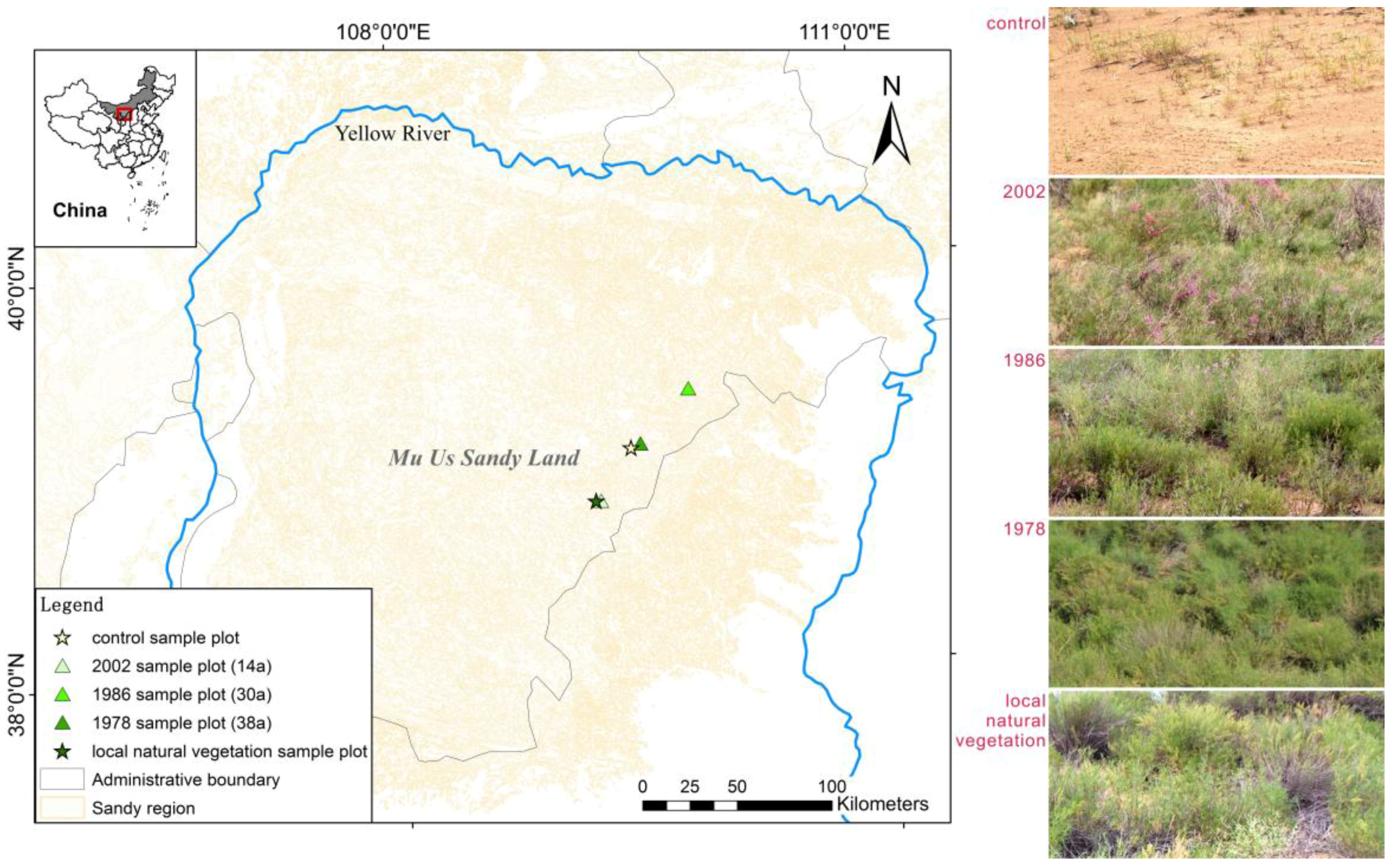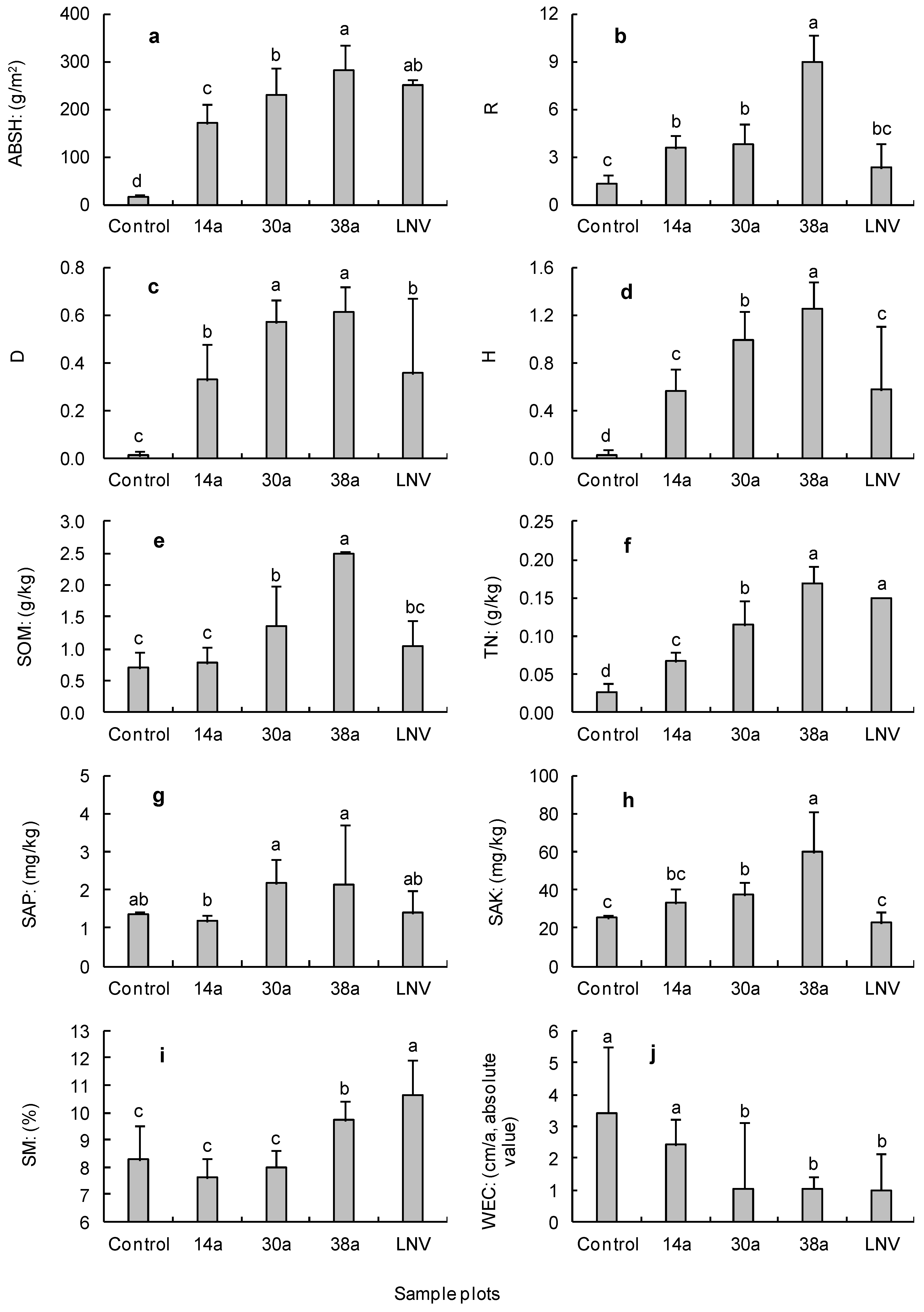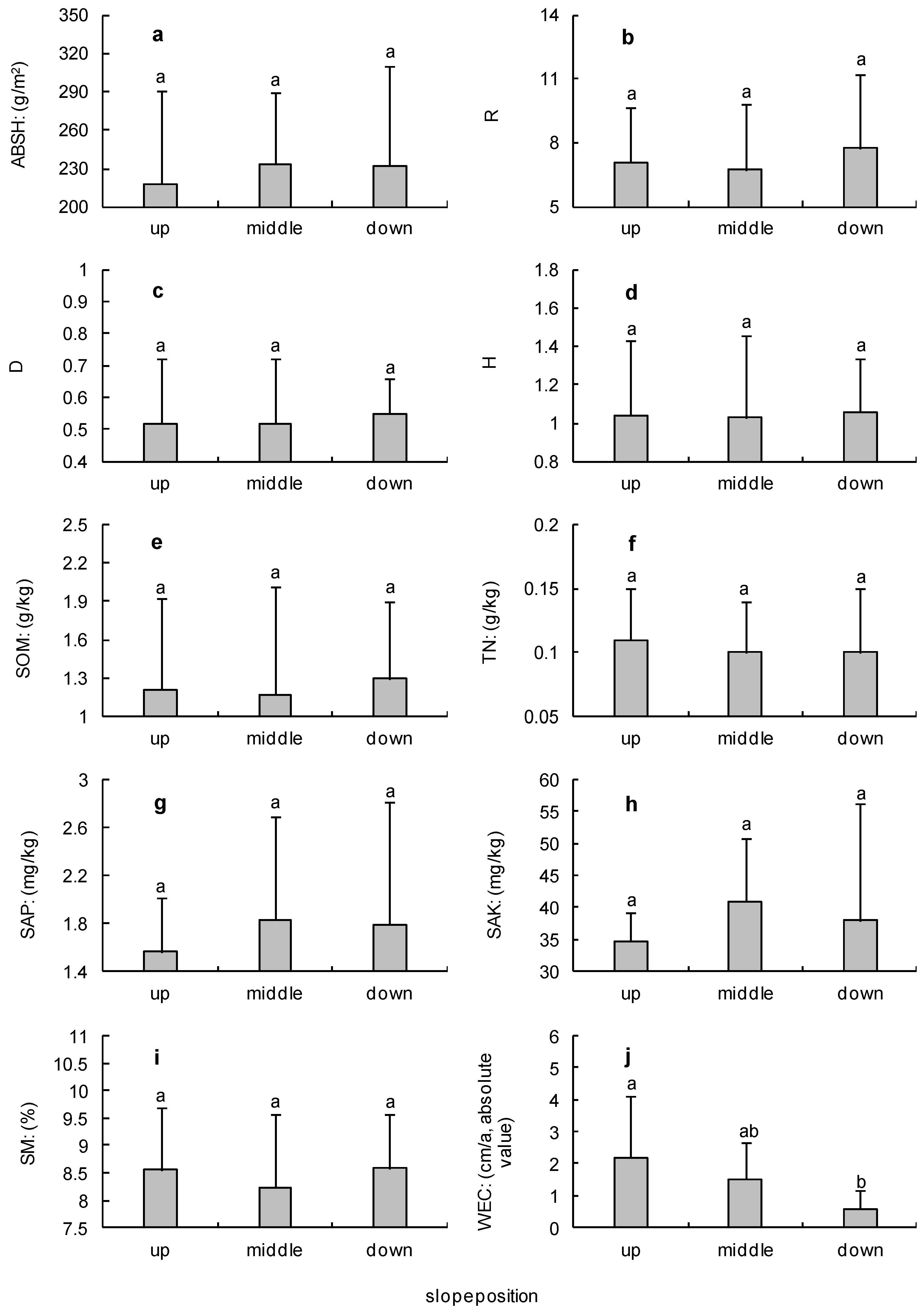Assessment of the Ecosystem Service Function of Sandy Lands at Different Times Following Aerial Seeding of an Endemic Species
Abstract
:1. Introduction
2. Materials and Methods
2.1. Study Area
2.2. Sample Plot Setup and Data Collection
2.2.1. Plant Community Investigation
2.2.2. Soil Sampling and Laboratory Analyses
2.2.3. Long-Term Monitoring of Soil Moisture
2.2.4. Long-Term Monitoring of Wind Erosion
2.3. Assessment Method
2.4. Data Analysis
2.4.1. Data Preparation
2.4.2. Un-Dimensioned of Data and Calculated the Final Assessment Value
2.4.3. Statistical Analysis
3. Results
3.1. Community Species Importance Values Change
3.2. Ecosystem Services Function Change
3.3. Ecosystem Service Function at Different Slope Positions
3.4. Relationships between the Service Indices
4. Discussion
5. Conclusions
Acknowledgments
Author Contributions
Conflicts of Interest
References
- Thomas, D.S.G. Science and the desertification debate. J. Arid Environ. 1997, 37, 599–608. [Google Scholar] [CrossRef]
- Bai, Y.F.; Huang, J.H.; Zheng, S.X.; Pan, Q.M.; Zhang, L.X.; Zhou, H.K.; Xu, H.L.; Li, Y.L.; Ma, J. Drivers and regulating mechanisms of grassland and desert ecosystem services. Chin. J. Plant Ecol. 2014, 38, 93–102. (In Chinese) [Google Scholar]
- Daily, G.C. Nature’s Services: Societal Dependence on Natural Ecosystems; Island Press: Washington, DC, USA, 1997; ISBN 1-55963-475-8. [Google Scholar]
- Balick, M.J.; Elisabetsky, E.; Laird, S.A. Medicinal Resources of the Tropical Forest: Biodiversity and Its Importance to Human Health; Columbia Univ. Press: New York, NY, USA, 1996. [Google Scholar]
- Tripathi, K.P.; Singh, B. Species diversity and vegetation structure across various strata in natural and plantation forests in Katerniaghat Wildlife Sanctuary, North India. Trop. Ecol. 2009, 50, 191–200. [Google Scholar]
- Shono, K.; Cadaweng, E.A.; Durst, P.B. Application of assisted natural regeneration to restore degraded tropical forestlands. Restor. Ecol. 2007, 15, 620–626. [Google Scholar] [CrossRef]
- Orians, G.H.; Pfeiffer, E.W. Ecological effects of the war in Vietnam. Science 1970, 168, 544–554. [Google Scholar] [CrossRef] [PubMed]
- Aide, T.M.; Zimmerman, J.K.; Herrera, L.; Rosario, M.; Serrano, M. Forest recovery in abandoned tropical pastures in Puerto Rico. For. Ecol. Manag. 1995, 77, 77–86. [Google Scholar] [CrossRef]
- Xiao, X.; Wei, X.H.; Liu, Y.Q.; Ouyang, X.Z.; Li, Q.L.; Ning, J.K. Aerial seeding: An effective forest restoration method in highly degraded forest landscapes of sub-tropic regions. Forests 2015, 6, 1748–1762. [Google Scholar] [CrossRef]
- Greipsson, S.; El-Mayas, H. Large-scale reclamation of barren lands in Iceland by aerial seeding. Land Degrad. Dev. 1999, 10, 185–193. [Google Scholar] [CrossRef]
- Narita, K.; Wada, N. Ecological significance of the aerial seed pool of a desert lignified annual, Blepharis sindica (Acanthaceae). Plant Ecol. 1998, 135, 177–184. [Google Scholar] [CrossRef]
- Davies, K.W.; Bates, J.D.; Madsen, M.D.; Nafus, A.M. Restoration of mountain big sagebrush steppe following prescribed burning to control western juniper. Environ. Manag. 2014, 53, 1015–1022. [Google Scholar] [CrossRef] [PubMed]
- Pyke, D.A.; Wirth, T.A.; Beyers, J.L. Does seeding after wildfires in rangelands reduce erosion or invasive species? Restor. Ecol. 2013, 21, 415–421. [Google Scholar] [CrossRef]
- Clements, W.H.; Vieira, N.K.M.; Church, S.E. Quantifying restoration success and recovery in a metal-polluted stream: A 17-year assessment of physicochemical and biological responses. J. Appl. Ecol. 2010, 47, 899–910. [Google Scholar] [CrossRef]
- Bullock, J.M.; Aronson, J.; Newton, A.C.; Pywell, R.F.; Reybenayas, J.M. Restoration of ecosystem services and biodiversity: Conflicts and opportunities. Trends Ecol. Evol. 2011, 26, 541–549. [Google Scholar] [CrossRef] [PubMed]
- Cao, S.X.; Chen, L.; Yu, X.X. Impact of China’s Grain for Green Project on the landscape of vulnerable arid and semi-arid agricultural regions: A case study in northern Shaanxi Province. J. Appl. Ecol. 2009, 46, 536–543. [Google Scholar] [CrossRef]
- Chazdon, R.L. Beyond deforestation: Restoring forests and ecosystem services on degraded lands. Science 2008, 320, 1458–1460. [Google Scholar] [CrossRef] [PubMed]
- Zhang, X.S. Principles and optimal models for development of Maowusu sandy grassland. Acta Ecol. Sin. 1994, 18, 1–16. (In Chinese) [Google Scholar]
- Tiemuer, B.; Tana; Hasi, M.; Huang, S.R. The development current situation and future development advice of the shrubbery in Wushen country. Prot. For. Sci. Technol. 2014, 124, 75–76. (In Chinese) [Google Scholar]
- Hein, L.; van Koppenb, K.; de Groot, R.S.D.; van Ierland, E.C. Spatial scales, stakeholders and the valuation of ecosystem services. Ecol. Econ. 2006, 57, 209–228. [Google Scholar] [CrossRef]
- Liu, F.H.; Ye, X.H.; Yu, F.H.; Dong, M. Clonal integration modifies responses of Hedysarum Laeve to local sand burial in Mu Us Sandland. Chin. J. Plant Ecol. 2006, 30, 278–285. (In Chinese) [Google Scholar]
- Xie, Y.Z.; Qiu, K.Y.; Xu, D.M.; Shi, X.F.; Qi, T.Y.; Richard, P. Spatial heterogeneity of soil and vegetation characteristics and soil-vegetation relationships along an ecotone in southern Mu Us Sandy Land, China. J. Soil Sediment 2015, 15, 1584–1601. [Google Scholar] [CrossRef]
- Wang, B.; Yang, F.W.; Guo, H.; Li, S.N.; Wang, Y.; Ma, X.Q.; Yu, X.X.; Lu, S.W.; Wang, H.W.; Wei, W.J. Specifications for Assessment of Forest Ecosystem Services in China; LY/T1721-2008; Standards Press of China: Beijing, China, 2008. (In Chinese) [Google Scholar]
- Ramanathan, R. A note on the use of the analytic hierarchy process for environmental impact assessment. J. Environ. Manag. 2001, 63, 27–35. [Google Scholar] [CrossRef] [PubMed]
- Nekooee, Z.; Karami, M.; Fakhari, I. Assessment and prioritization of urban tourist attractions based on analytical hierarchy process (AHP) (a case study of Birjand, Iran). Ecography 2011, 35, 65–72. [Google Scholar]
- Wilcox, J.C.; Healy, M.T.; Zedler, J.B. Restoring native vegetation to an urban wet meadow dominated by reed canarygrass (Phalaris arundinacea L.) in Wisconsin. Nat. Area J. 2015, 27, 354–365. [Google Scholar] [CrossRef]
- Shen, W.S. Successional Stage and rate of the aerial seeding vegetation in the Maowusu Sandyland. Sci. Silvae Sin. 1999, 35, 103–108. (In Chinese) [Google Scholar] [CrossRef]
- Zhu, Y.J.; Alaten, B.; Dong, M.; Huang, Z.Y. Effects of increasing water or nutrient supplies on reproduction trade-offs in the natural populations of clonal plant, Hedysarum laeve. Chin. J. Plant Ecol. 2007, 31, 658–664. (In Chinese) [Google Scholar]
- Bassett, O.D.; Prior, L.D.; Slijkerman, C.M.; Jamieson, D.; Bowman, D.M.J.S. Aerial sowing stopped the loss of alpine ash (Eucalyptus delegatensis) forests burnt by three short-interval fires in the Alpine National Park, Victoria, Australia. For. Ecol. Manag. 2015, 342, 39–48. [Google Scholar] [CrossRef]
- McLaughlin, B.E.; Crowder, A.A. The distribution of Agrostis gigantea and Poa pratensis in relation to some environmental factors on a mine-tailings area at Copper Cliff, Ontario. Can. J. Bot. 1988, 66, 2317–2322. [Google Scholar] [CrossRef]
- Nehring, S.; Hesse, K.J. Invasive alien plants in marine protected areas: The Spartina anglica affair in the European Wadden Sea. Biol. Invasions 2008, 10, 937–950. [Google Scholar] [CrossRef]
- Del Barrio, G.; Alvera, B.; Puigdefabregas, J.; Diez, C. Response of high mountain landscape to topographic variables: Central Pyrenees. Landsc. Ecol. 1997, 12, 95–115. [Google Scholar] [CrossRef]
- Tatian, M.; Arzani, H.; Reihan, M.K.; Bahmanyar, M.A.; Jalilvand, H. Effect of soil and physiographic factors on ecological plant groups in the eastern Elborz mountain rangeland of Iran. Grassl. Sci. 2010, 56, 77–86. [Google Scholar] [CrossRef]
- Kidron, G.J. Differential water distribution over dune slopes as affected by slope position and microbiotic crust, Negev Desert, Israel. Hydrol. Process 1999, 13, 1665–1682. [Google Scholar] [CrossRef]
- Nagamatsu, D.; Hirabuki, Y.; Mochida, Y. Influence of micro-landforms on forest structure, tree death and recruitment in a Japanese temperate mixed forest. Ecol. Res. 2003, 18, 533–547. [Google Scholar] [CrossRef]
- Gamfeldt, L.; Snäll, T.; Bagchi, R.; Jonsson, M.; Gustafsson, L.; Kjellander, P.; Ruiz-Jaen, M.C.; Fröberg, M.; Stendahl, J.; Philipson, C.D.; et al. Higher levels of multiple ecosystem services are found in forests with more tree species. Nat. Commun. 2011, 4, 1–8. [Google Scholar] [CrossRef] [PubMed] [Green Version]
- Feng, Q.; Zhao, W.W.; Fu, B.J.; Ding, J.Y.; Wang, S. Ecosystem service trade-offs and their influencing factors: A case study in the Loess Plateau of China. Sci. Total Environ. 2017, 607–608, 1250–1263. [Google Scholar] [CrossRef] [PubMed]
- Isbell, F.; Calcagno, V.; Hector, A.; Connolly, J.; Harpole, W.S.; Reich, P.B.; Scherer-Lorenzen, M.; Schmid, B.; Tilman, D.; van Ruijven, J.; et al. High plant diversity is needed to maintain ecosystem services. Nature 2011, 477, 199–202. [Google Scholar] [CrossRef] [PubMed] [Green Version]
- Balvanera, P.; Pfisterer, A.B.; Buchmann, N.; He, J.S.; Nakashizuka, T.; Raffaelli, D.; Schmid, B. Quantifying the evidence for biodiversity effects on ecosystem functioning and services. Ecol. Lett. 2006, 9, 1146–1156. [Google Scholar] [CrossRef] [PubMed] [Green Version]
- Bu, W.S.; Zang, R.G.; Ding, Y. Field observed relationships between biodiversity and ecosystem functioning during secondary succession in a tropical lowland rainforest. Acta Oecol. 2014, 55, 1–7. [Google Scholar] [CrossRef]
- Mace, G.M.; Norris, K.; Fitter, A.H. Biodiversity and ecosystem services: A multilayered relationship. Trends Ecol. Evol. 2012, 27, 19–26. [Google Scholar] [CrossRef] [PubMed]
- Luck, G.W.; Daily, G.C.; Ehrlich, P.R. Population diversity and ecosystem services. Trends Ecol. Evol. 2003, 18, 331–336. [Google Scholar] [CrossRef]



| Sample Plot | Geographical Position (Latitude and Longitude) | Altitude (m) | Aerial Seeding Species | Site Types before Aerial Seeding | Seeding Density (kg/hm2) | Area (hm2) |
|---|---|---|---|---|---|---|
| Elapsed time after aerial seeding (a) | ||||||
| 14 (in 2002) | N:38°51′ E:109°15′ | 1309 | H. laeve | Moving and semi-moving sandy land | 8–9 | 667 |
| 30 (in 1986) | N:39°23′ E:109°50′ | 1329 | H. laeve | Moving and semi-moving sandy land | 8–9 | 333 |
| 38 (in 1978) | N:39°08′ E:109°31′ | 1350 | H. laeve | Moving and semi-moving sandy land | 8–9 | 667 |
| Others | ||||||
| Control | N:39°07′ E:109°27′ | 1391 | Not Implemented | Moving and semi-moving sandy land in 1978 | / | / |
| Local natural vegetation | N:38°52′ E:109°13′ | 1306 | Not Implemented | Always been A. ordosica community | / | / |
| Total Target Layer | Criteria Layer | Weight | Index Layer | Weight | Combined Weight | Index Attribute |
|---|---|---|---|---|---|---|
| A Ecosystem service function assessment | B1 Carbon sequestration ability | 0.08 | C1 Aboveground biomass per unit area of shrub (ABS) + Aboveground biomass per unit area of herb (ABH) (ABSH) | 1.00 | 0.0833 | positive |
| B2 Biodiversity | 0.25 | C2 Richness index (R) | 0.33 | 0.0833 | positive | |
| C3 Simpson index (D) | 0.33 | 0.0833 | positive | |||
| C4 Shannon–Wiener index (H) | 0.33 | 0.0833 | positive | |||
| B3 Soil fertility | 0.08 | C5 Soil organic matter (SOM) | 0.50 | 0.0417 | positive | |
| C6 Total nitrogen (TN) | 0.25 | 0.0208 | positive | |||
| C7 Soil available phosphorus (SAP) | 0.13 | 0.0104 | positive | |||
| C8 Soil available potassium (SAK) | 0.13 | 0.0104 | positive | |||
| B4 Water conservation functions | 0.17 | C9 Soil moisture (SM) | 1.00 | 0.1667 | positive | |
| B5 Wind-break and sand-fixation | 0.42 | C10 Wind erosion spile height change (WEC) | 1.00 | 0.4167 | negative |
| Species | Control | Elapsed Time after Aerial Seeding (a) | Local Natural Vegetation | ||
|---|---|---|---|---|---|
| 14 | 30 | 38 | |||
| Shrub layer | |||||
| H. laeve Maxim. | - | 0.9502 | 0.6255 | 0.4994 | - |
| A. ordosica Krasch | - | 0.0498 | 0.3745 | 0.5006 | 1.0000 |
| Herb layer | |||||
| Bassia dasyphylla (Fisch. et Mey.) O. Kuntze | 0.0858 | 0.4644 | 0.0449 | 0.0245 | - |
| Corispermum mongolicum Iljin | 0.9142 | 0.3471 | 0.1849 | - | 0.5620 |
| Ixeridium graminifolium (Ledeb.) Tzvel. | - | 0.1123 | 0.0105 | 0.0431 | 0.0569 |
| Setaria viridis (L.) Beauv. | - | 0.0319 | 0.2553 | - | - |
| Incarvillea sinensis Lam. | - | 0.0177 | - | - | - |
| Cynanchum thesioides (Freyn) K. Schum. | - | 0.0098 | - | 0.0077 | 0.0813 |
| Sonchus brachyotus DC. | - | 0.0091 | - | - | - |
| Heteropappus altaicus (Willd.) Novopokr. | - | 0.0078 | - | 0.0409 | - |
| Euphorbia humifusa Willd. ex Schlecht. | - | - | 0.1557 | - | - |
| Chenopodium aristatum L. | - | - | 0.1444 | - | - |
| Chenopodium glaucum L. | - | - | 0.1364 | 0.0084 | - |
| Euphorbia esula L. | - | - | 0.0449 | 0.0388 | - |
| Silene jenisseensis Willd. | - | - | 0.0101 | 0.0222 | - |
| Poa sphondylodes Trin. | - | - | 0.0130 | - | - |
| Artemisia hedinii Ostenf. et Pauls. | - | - | - | 0.0188 | - |
| Eragrostis minor Host | - | - | - | 0.0448 | 0.0569 |
| Allium mongolicum Regel | - | - | - | 0.0374 | - |
| Leontopodium leontopodioides (Willd. ) Beauv. | - | - | - | 0.0215 | - |
| Leymus chinensis (Trin.) Tzvel. | - | - | - | 0.5117 | 0.2429 |
| Tribulus terrester L. | - | - | - | 0.0060 | - |
| Cynanchum hancockianum (Maxim.) Al. Iljinski | - | - | - | 0.0398 | - |
| Artemisia sphaerocephala Krasch. | - | - | - | 0.0191 | - |
| Inula salsoloides (Turcz. ) Ostenf. | - | - | - | 0.0263 | - |
| Thalictrum petaloideum L. | - | - | - | 0.0691 | - |
| Salsola collina Pall. | - | - | - | 0.0200 | - |
| Index | Control | Elapsed Time after Aerial Seeding (a) | Local Natural Vegetation | ||
|---|---|---|---|---|---|
| 14 | 30 | 38 | |||
| C1 ABSH | 6.27 | 60.50 | 81.69 | 100.00 | 89.23 |
| C2 R | 14.81 | 39.81 | 42.59 | 100.00 | 25.93 |
| C3 D | 1.87 | 53.74 | 92.95 | 100.00 | 58.31 |
| C4 H | 2.34 | 45.10 | 79.25 | 100.00 | 45.95 |
| C5 SOM | 27.96 | 31.03 | 54.23 | 100.00 | 41.93 |
| C6 TN | 15.99 | 39.99 | 67.74 | 100.00 | 88.43 |
| C7 SAP | 63.83 | 54.74 | 100.00 | 99.17 | 64.83 |
| C8 SAK | 42.11 | 54.94 | 62.49 | 100.00 | 38.14 |
| C9 SM | 77.49 | 71.52 | 75.15 | 91.27 | 100.00 |
| C10 WEC | 29.13 | 41.38 | 96.77 | 96.00 | 100.00 |
| Assessment Value (Xi) | 29.76 | 49.02 | 82.91 | 96.86 | 81.28 |
| Index | Slope Positions | ||
|---|---|---|---|
| Up | Middle | Down | |
| C1 ABSH | 93.49 | 100.00 | 99.62 |
| C2 R | 91.35 | 87.10 | 100.00 |
| C3 D | 94.55 | 94.55 | 100.00 |
| C4 H | 98.11 | 97.17 | 100.00 |
| C5 SOM | 93.80 | 90.70 | 100.00 |
| C6 TN | 100.00 | 90.91 | 90.91 |
| C7 SAP | 85.25 | 100.00 | 97.81 |
| C8 SAK | 84.75 | 100.00 | 92.75 |
| C9 SM | 99.65 | 96.04 | 100.00 |
| C10 WEC | 26.61 | 37.91 | 100.00 |
| Assessment Value (Xi) | 66.90 | 71.11 | 99.67 |
| ABSH | R | D | H | SOM | TN | SAP | SAK | SM | WEC | |
|---|---|---|---|---|---|---|---|---|---|---|
| ABSH | 1 | |||||||||
| R | 0.651 ** | 1 | ||||||||
| D | 0.371 * | 0.387 * | 1 | |||||||
| H | 0.441 ** | 0.529 ** | 0.959 ** | 1 | ||||||
| SOM | 0.429 * | 0.711 ** | 0.532 ** | 0.652 ** | 1 | |||||
| TN | 0.185 | 0.258 | 0.599 ** | 0.610 ** | 0.265 | 1 | ||||
| SAP | 0.325 | 0.418 * | 0.479 * | 0.545 ** | 0.506 ** | 0.391 | 1 | |||
| SAK | 0.399 * | 0.676 ** | 0.334 | 0.423 * | 0.600 ** | 0.267 | 0.490 ** | 1 | ||
| SM | 0.439 ** | 0.667 ** | 0.471 ** | 0.524 ** | 0.376 | 0.406* | 0.095 | 0.12 | 1 | |
| WEC | −0.273 | −0.321 | −0.215 | −0.342 * | −0.277 | −0.178 | −0.353 | −0.269 | −0.173 | 1 |
© 2018 by the authors. Licensee MDPI, Basel, Switzerland. This article is an open access article distributed under the terms and conditions of the Creative Commons Attribution (CC BY) license (http://creativecommons.org/licenses/by/4.0/).
Share and Cite
Zhang, L.; Hong, G.; Li, Z.; Gao, X.; Wu, Y.; Wang, X.; Wang, P.; Yang, J. Assessment of the Ecosystem Service Function of Sandy Lands at Different Times Following Aerial Seeding of an Endemic Species. Sustainability 2018, 10, 902. https://doi.org/10.3390/su10040902
Zhang L, Hong G, Li Z, Gao X, Wu Y, Wang X, Wang P, Yang J. Assessment of the Ecosystem Service Function of Sandy Lands at Different Times Following Aerial Seeding of an Endemic Species. Sustainability. 2018; 10(4):902. https://doi.org/10.3390/su10040902
Chicago/Turabian StyleZhang, Lei, Guangyu Hong, Zhuofan Li, Xiaowei Gao, Yongzhi Wu, Xiaojiang Wang, Pingping Wang, and Jie Yang. 2018. "Assessment of the Ecosystem Service Function of Sandy Lands at Different Times Following Aerial Seeding of an Endemic Species" Sustainability 10, no. 4: 902. https://doi.org/10.3390/su10040902





